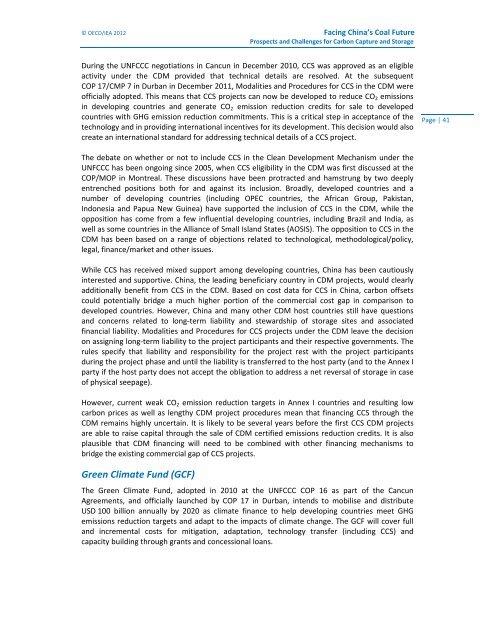Facing China's Coal Future - IEA
Facing China's Coal Future - IEA
Facing China's Coal Future - IEA
Create successful ePaper yourself
Turn your PDF publications into a flip-book with our unique Google optimized e-Paper software.
© OECD/<strong>IEA</strong> 2012 <strong>Facing</strong> China’s <strong>Coal</strong> <strong>Future</strong><br />
Prospects and Challenges for Carbon Capture and Storage<br />
During the UNFCCC negotiations in Cancun in December 2010, CCS was approved as an eligible<br />
activity under the CDM provided that technical details are resolved. At the subsequent<br />
COP 17/CMP 7 in Durban in December 2011, Modalities and Procedures for CCS in the CDM were<br />
officially adopted. This means that CCS projects can now be developed to reduce CO 2 emissions<br />
in developing countries and generate CO 2 emission reduction credits for sale to developed<br />
countries with GHG emission reduction commitments. This is a critical step in acceptance of the<br />
technology and in providing international incentives for its development. This decision would also<br />
create an international standard for addressing technical details of a CCS project.<br />
Page | 41<br />
The debate on whether or not to include CCS in the Clean Development Mechanism under the<br />
UNFCCC has been ongoing since 2005, when CCS eligibility in the CDM was first discussed at the<br />
COP/MOP in Montreal. These discussions have been protracted and hamstrung by two deeply<br />
entrenched positions both for and against its inclusion. Broadly, developed countries and a<br />
number of developing countries (including OPEC countries, the African Group, Pakistan,<br />
Indonesia and Papua New Guinea) have supported the inclusion of CCS in the CDM, while the<br />
opposition has come from a few influential developing countries, including Brazil and India, as<br />
well as some countries in the Alliance of Small Island States (AOSIS). The opposition to CCS in the<br />
CDM has been based on a range of objections related to technological, methodological/policy,<br />
legal, finance/market and other issues.<br />
While CCS has received mixed support among developing countries, China has been cautiously<br />
interested and supportive. China, the leading beneficiary country in CDM projects, would clearly<br />
additionally benefit from CCS in the CDM. Based on cost data for CCS in China, carbon offsets<br />
could potentially bridge a much higher portion of the commercial cost gap in comparison to<br />
developed countries. However, China and many other CDM host countries still have questions<br />
and concerns related to long‐term liability and stewardship of storage sites and associated<br />
financial liability. Modalities and Procedures for CCS projects under the CDM leave the decision<br />
on assigning long‐term liability to the project participants and their respective governments. The<br />
rules specify that liability and responsibility for the project rest with the project participants<br />
during the project phase and until the liability is transferred to the host party (and to the Annex I<br />
party if the host party does not accept the obligation to address a net reversal of storage in case<br />
of physical seepage).<br />
However, current weak CO 2 emission reduction targets in Annex I countries and resulting low<br />
carbon prices as well as lengthy CDM project procedures mean that financing CCS through the<br />
CDM remains highly uncertain. It is likely to be several years before the first CCS CDM projects<br />
are able to raise capital through the sale of CDM certified emissions reduction credits. It is also<br />
plausible that CDM financing will need to be combined with other financing mechanisms to<br />
bridge the existing commercial gap of CCS projects.<br />
Green Climate Fund (GCF)<br />
The Green Climate Fund, adopted in 2010 at the UNFCCC COP 16 as part of the Cancun<br />
Agreements, and officially launched by COP 17 in Durban, intends to mobilise and distribute<br />
USD 100 billion annually by 2020 as climate finance to help developing countries meet GHG<br />
emissions reduction targets and adapt to the impacts of climate change. The GCF will cover full<br />
and incremental costs for mitigation, adaptation, technology transfer (including CCS) and<br />
capacity building through grants and concessional loans.
















